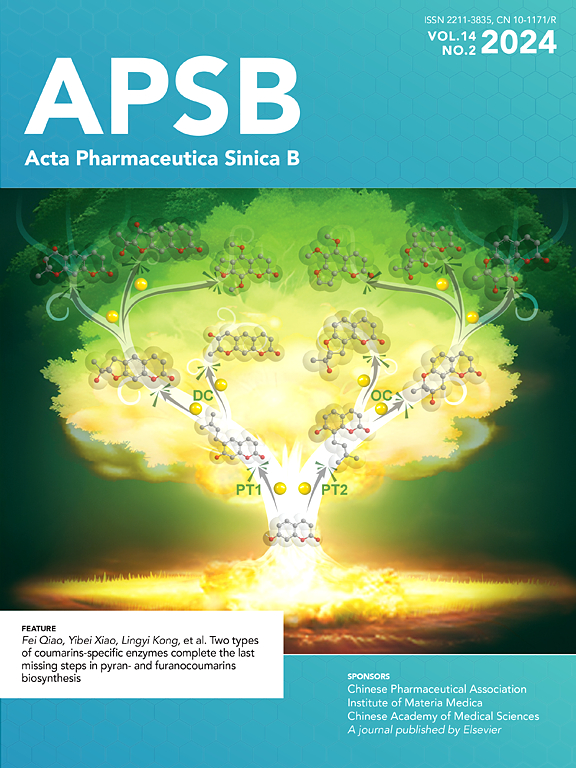咖啡酸钒纳米酶通过巨噬细胞重编程和上调X连锁凋亡蛋白抑制因子治疗皮瓣缺血再灌注损伤
IF 14.7
1区 医学
Q1 PHARMACOLOGY & PHARMACY
引用次数: 0
摘要
皮瓣移植后的缺血再灌注(I/R)损伤是导致皮瓣坏死和移植失败的关键因素。拮抗炎症反应和氧化应激被认为是减轻再灌注损伤和提高皮瓣存活率的关键目标。本研究制备了咖啡酸-钒金属多酚纳米颗粒(CA-V NPs),用于治疗皮瓣缺血和再灌注。该研究采用一步法制备了大小均匀、结构稳定的新型CA-V NPs。结果表明,CA-V NPs具有类似CAT和SOD的活性,能有效清除ROS、产生氧气并缓解氧化应激。在 HO 诱导的细胞氧化应激模型中,CA-V NPs 能有效降低 ROS 水平,并通过 XIAP/Caspase-3 途径抑制细胞凋亡。在 LPS 与 IFN- 共同诱导的细胞炎症模型中,CA-V NPs 可使巨噬细胞向 M2 表型极化重编程,并通过减少趋化因子 CCL4 和 CXCL2 的表达来减轻炎症反应。此外,动物实验表明,CA-V NPs 能减轻皮瓣组织的氧化应激,抑制细胞凋亡,促进血管生成,最终提高皮瓣的存活率。CA-V NPs为治疗皮瓣I/R损伤提供了新的靶点和策略。本文章由计算机程序翻译,如有差异,请以英文原文为准。

Caffeic acid-vanadium nanozymes treat skin flap ischemia-reperfusion injury through macrophage reprogramming and the upregulation of X-linked inhibitors of apoptotic proteins
Ischemia-reperfusion (I/R) injury following skin flap transplantation is a critical factor leading to flap necrosis and transplant failure. Antagonizing inflammatory responses and oxidative stress are regarded as crucial targets for mitigating reperfusion injury and enhancing flap survival. In this study, caffeic acid-vanadium metal polyphenol nanoparticles (CA-V NPs) were prepared for the treatment of skin flap ischemia and reperfusion. This study was conducted using a one-step method to prepare new types of CA-V NPs with uniform sizes and stable structures. In vitro, the CA-V NPs exhibited CAT-like and SOD-like activities and could effectively scavenge ROS, generate oxygen, and alleviate oxidative stress. In the H2O2-induced cellular oxidative stress model, CA-V NPs effectively reduced ROS levels and inhibited apoptosis through the XIAP/Caspase-3 pathway. In the cellular inflammation model induced by LPS combined with IFN-γ, CA-V NPs reprogrammed macrophage polarization toward the M2 phenotype and reduced inflammatory responses by reducing the expression of the chemokines CCL4 and CXCL2. In addition, animal experiments have shown that CA-V NPs can alleviate oxidative stress in skin flap tissues, inhibit apoptosis, promote angiogenesis, and ultimately improve the survival rate of skin flaps. CA-V NPs provide a new target and strategy for the treatment of flap I/R injury.
求助全文
通过发布文献求助,成功后即可免费获取论文全文。
去求助
来源期刊

Acta Pharmaceutica Sinica. B
Pharmacology, Toxicology and Pharmaceutics-General Pharmacology, Toxicology and Pharmaceutics
CiteScore
22.40
自引率
5.50%
发文量
1051
审稿时长
19 weeks
期刊介绍:
The Journal of the Institute of Materia Medica, Chinese Academy of Medical Sciences, and the Chinese Pharmaceutical Association oversees the peer review process for Acta Pharmaceutica Sinica. B (APSB).
Published monthly in English, APSB is dedicated to disseminating significant original research articles, rapid communications, and high-quality reviews that highlight recent advances across various pharmaceutical sciences domains. These encompass pharmacology, pharmaceutics, medicinal chemistry, natural products, pharmacognosy, pharmaceutical analysis, and pharmacokinetics.
A part of the Acta Pharmaceutica Sinica series, established in 1953 and indexed in prominent databases like Chemical Abstracts, Index Medicus, SciFinder Scholar, Biological Abstracts, International Pharmaceutical Abstracts, Cambridge Scientific Abstracts, and Current Bibliography on Science and Technology, APSB is sponsored by the Institute of Materia Medica, Chinese Academy of Medical Sciences, and the Chinese Pharmaceutical Association. Its production and hosting are facilitated by Elsevier B.V. This collaborative effort ensures APSB's commitment to delivering valuable contributions to the pharmaceutical sciences community.
 求助内容:
求助内容: 应助结果提醒方式:
应助结果提醒方式:


